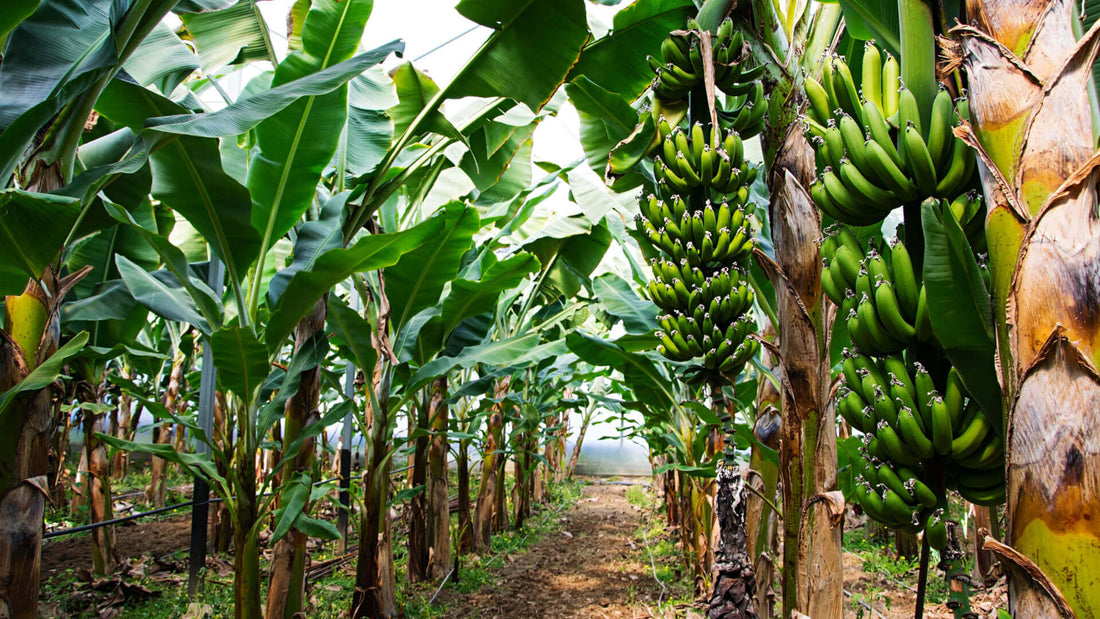
The Fascinating Life Cycle of a Banana Tree
Share
Life Cycle of Banana Trees
Banana trees, with their vibrant green leaves and bunches of delicious fruit, are common in tropical regions worldwide. While many of us enjoy the sweet and nutritious fruit they produce, few people are familiar with the intricate and fascinating life cycle of these remarkable plants. From tiny seeds to towering trees, the trees have a life cycle that is both unique and essential to their survival.
The trees belong to the Musaceae family, which includes several species and varieties. One of the most widely cultivated species is the Musa acuminata. A tree's life cycle begins with the germination of its seeds. Unlike most fruit-bearing plants, the trees do not grow from the seeds of the fruit we consume. Instead, they grow from seeds produced by the fruit's flowers. These tiny, black seeds are surrounded by a gel-like substance that aids in their dispersal.
Germination starts when a seed is revealed to beneficial conditions, including warmth, moisture, and oxygen. Once these conditions are met, the seed coat softens, allowing the embryo to grow inside. A tiny sprout emerges, which eventually forms the plant's first leaves. These initial leaves are often known as cotyledons and are critical for the early growth and nutrition of the plant.
As the tree grows, it develops a root system that anchors it firmly in the soil. The roots provide stability and absorb essential nutrients and water from the ground. The tree's ability to establish a robust root system is vital for long-term survival, especially in regions with heavy rainfall and strong winds.
After the initial growth phase, the tree enters a vegetative stage characterized by the rapid development of leaves. The leaves are large, elongated, and spirally arranged, forming a crown at the top of the tree. These leaves play a crucial role in the plant's life cycle by capturing sunlight and converting it into energy through photosynthesis. The power generated from photosynthesis is essential for producing flowers and fruit.
The trees have a unique growth pattern known as monocarpic flowering. This means that the plant only flowers once in its lifetime. The flowering process is initiated when the tree achieves a specific level of maturity, typically after 9 to 15 months of growth. However, the precise timing can vary depending on environmental conditions and the variety.
The Banana Tree Has A Remarkable Bloom
The emergence of the flower is a remarkable event in the tree's life cycle. The flower is significant, and its appearance is often striking, with vibrant colors ranging from red to purple. The flower contains male and female reproductive organs, making it self-fertile. However, the structure of the flower makes it challenging for self-pollination to occur naturally.
To ensure successful pollination and fruit development, the trees rely on the assistance of pollinators, such as bees and hummingbirds. These creatures are attracted to colorful and fragrant flowers and play a vital role in transferring pollen between the male and female regions of the flower. Once pollinated, the female flowers develop into fruit, while the male flowers wither and drop from the tree.
One of the most intriguing aspects of the trees is the unique way their fruit develops. They grow in clusters known as "hands," with each hand containing multiple individual fruits called "fingers." The fruit begins as a small, green bump at the base of the female flower and gradually elongates as it matures. As it grows, the fruit undergoes a remarkable transformation.
The green, unripe fruit that we are familiar with are primarily composed of starch. As the fruit matures, enzymes within the fruit begin to convert the starch into sugars, such as glucose and fructose. This process is responsible for the sweet taste and the change in color from green to yellow or even red, depending on the variety. Additionally, the texture of the fruit becomes smoother and more appealing to the palate.
While the fruit is still attached to the tree, it receives nutrients and water from the plant's vascular system, which is transported through the stem, also known as the pseudostem. The pseudostem is not a stem but a collection of tightly packed leaf bases. It provides structural support to the plant and is necessary to deliver nutrients to the developing fruit.
Once the fruit reaches the desired size and ripeness, it is ready for harvest. Harvest timing is crucial, as they can become overripe if left on the tree for too long. To ensure that the fruit remains in optimal condition, it is carefully cut from the tree while still green and allowed to ripen off the plant. This practice allows for better control over the ripening process and helps prevent damage to the fruit during transport.
Banana Trees Provide A Valuable Food Source Worldwide
They are a valuable food source for people worldwide, providing essential vitamins, minerals, and carbohydrates. They are consumed fresh and used in various culinary applications, from baking to smoothie-making. The versatile nature of the fruit makes them a staple in many diets and a crucial part of global food security.
The life cycle of a tree does not end with the harvest of its fruit. After the fruit is removed, the plant's pseudostem begins to wither and die. However, the tree has a unique ability to regenerate itself through a process called sucker formation. Suckers are little sprouts that appear from the base of the parent plant. These shoots can be carefully separated from the parent and replanted, allowing for the continuous cultivation of new trees.
The ability to produce suckers is one of the reasons why the trees are such a valuable crop. It allows for the sustainable and ongoing fruit production from the same parent plant. Additionally, suckers are more disease-resistant than starting from seeds, which can be susceptible to pathogens.
As the sucker grows into a mature tree, the cycle begins anew. It will go through the same stages of germination, vegetative growth, flowering, and fruit production. This cycle repeats itself, ensuring a consistent supply of fruit for years. It is worth noting that the mother plant, from which the suckers are taken, eventually ceases to produce fruit after its one-time flowering. Still, its genetic legacy lives on through its offspring.
The trees are not only fascinating due to their unique life cycle but also because of their economic and ecological importance. They are a significant source of income for many tropical regions, providing employment opportunities for farmers and contributing to local economies. The cultivation of them also plays a crucial role in conserving biodiversity by preserving natural habitats and promoting sustainable agricultural practices.
In addition to their economic and ecological importance, the trees have cultural significance in various parts of the world. They are often used in rituals, ceremonies, and celebrations. For example, in some cultures, the leaves wrap food, and the fruit is offered as a symbol of hospitality and friendship.
Furthermore, they have a reputation for being a nutritious and energy-boosting snack. They contain necessary vitamins and minerals, including vitamin C, potassium, and B6. They are a favorite among athletes for their quick and natural energy source, making them an excellent choice for pre-and post-workout snacks.
The life cycle of a banana tree is a remarkable journey, from the tiny seeds germinating into robust plants to the vibrant flowers that attract pollinators and the delicious fruit that nourishes millions. It is a cycle filled with beauty, utility, and sustainability. They are a tasty treat and a symbol of the intricate relationship between plants and their environment and their vital role in our global food system.
